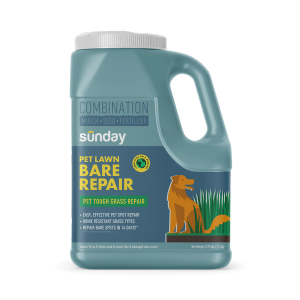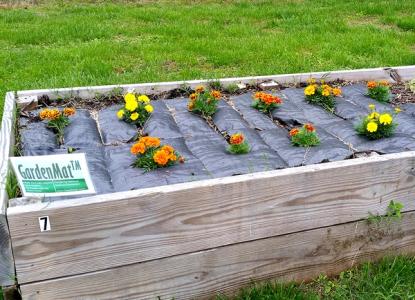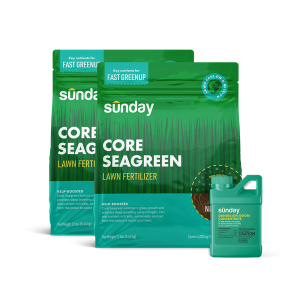What is soil texture?
The five senses can help us greatly if we are trying to better understand our soils. How it looks and how it smells, of course—but, did you know how soil feels can tell us quite a bit of information too? This is because of the different sizes and shapes of individual particles that make up the three main soil types: sand, silt, and clay.
- Sand: Sand particles are between 0.05–2 mm. These are the largest soil particles, maxing out about as thick as a nickel. Because these tiny rock fragments have sharp edges, sand feels gritty and rough.
- Clay: Clay particles are the smallest at less than 0.002 mm—that's 100 times smaller than sand. Because these particles are so small and often stick together, clay soils tend to feel smooth and a little sticky.
- Silt: Silt particles fall right in the middle, size-wise at 0.05–0.002 mm. That is 10 times smaller than sand and 10 times larger than clay. Silty soil feels smooth and powdery, like flour.
Soil will always have a mixture of these three soil particles. This mixture is what determines your soil texture. How? Each component of the mix is identified by percentages and knowing the percentages tells us which textural class that soil sample belongs to.
Why does soil texture matter?
Soil texture is the makeup of soil consisting of various shapes and sizes of soil particles. Knowing soil texture tells us more about the characteristics of your soil—like its water-holding capacity, nutrient retention, organic matter, overall soil structure, and more.
Water-holding capacity
Courser textured, sandy soils do not store water very well because water drains more freely out of large pores between sand particles. Sandy soils are often associated with drought. Opposite to that, water is tightly held together by clay because of the small pores between the small clay particles. Clay drains slowly, sand drains rapidly.
Nutrients
Finer textured soils—those dominated by clay—hold on to nutrients better, too. This has to do with their small size and electrical charge. Clay within soils usually influences the soil’s fertility. Sand, a.k.a. tiny rock fragments, does not have the ability to retain nutrients.
Compaction
Sandy soils can withstand activities that result in compaction better than soils with more clay. Even when compressed, sandy soils have more pore space than clay soils compacted together, especially when wet.
The Soil Texture Triangle
The soil texture triangle uses percentages of soil particles (remember: sand, silt, and clay) to help determine which textural class a soil sample belongs to. While there are officially 12 different soil textural classifications, sometimes you can make a close guess simply based on how the soil feels and behaves. For example, sandy soils tend to feel grainy while more clay-like soils tend to feel smooth and a little heavy.
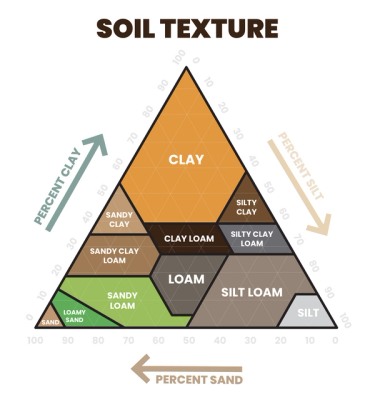
How to use the soil triangle
Imagine you have a random soil sample composed of ~50% sand, ~30% silt, and ~20% clay. The goal of using the soil triangle is to see where these 3 points meet using the numbers on the edges of the triangle and the light diagonal lines.
- First, notice that each of the three major soil types is located in its own corner and edge of the triangle. Then find 50% sand, 20% clay and 30% silt along the edges of the triangle.
- Using your eyes (or tracing your fingers), find where those points meet within the triangle.
- Using this method, you should discover that your sample falls into the "loam" section of the triangle—what an ideal soil composition you have!
Sunday Tip:
The more in the middle and/or bottom area of the triangle, the more ideal that soil texture is for growing most plants. This is because loam is a good mixture of sand, silt, and clay and balances out what all three soil types bring to the table.
How to texture your soil
Want to know what your soil texture is using your own hands? Grab some soil, maybe a little water (a couple of drops will do), and follow this easy guide to get started.
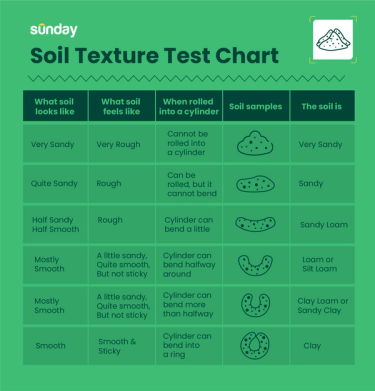
Sunday Tip:
Want to confirm your texture? You can find your predicted soil percentages in the ”My Lawn Data” section of your Sunday account!
Cited sources
Sand, Silt, and Clay. Michigan State University
Soil Texture. Cornell University Cooperative Extension.
Soil Texture and Soil Structure. University of Hawai’i at Manoa.
Soil Types. The University of Illinois Extension








